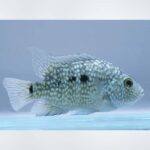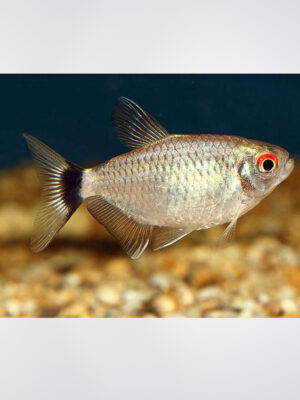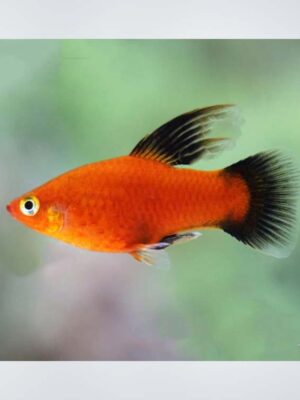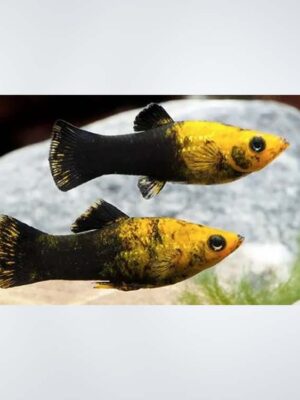Description
Tiger Barb (Puntigrus tetrazona) – Comprehensive Overview
The Tiger Barb, scientifically known as Puntigrus tetrazona, is a popular freshwater fish celebrated for its striking appearance and active behavior. Native to Southeast Asia, particularly in the river basins of Sumatra, Borneo, and the Malay Peninsula, these fish are commonly found in schools, making them ideal for community aquariums.
Appearance
Tiger Barbs are easily recognizable due to their vibrant coloration and unique pattern. They typically grow to a size of 2 to 3 inches (5 to 7.5 cm) and are characterized by their elongated bodies and bold, dark vertical stripes that resemble a tiger’s pattern. Their base color ranges from bright orange to yellow, complemented by their striking black stripes. Additionally, they possess a distinctive fin shape, with the dorsal and anal fins often exhibiting a bright red or orange hue.
Behavior and Temperament
Tiger Barbs are lively and playful fish, known for their social behavior. They are best kept in groups of 6 or more to minimize aggression, as they can become nippy towards other fish, especially those with long fins. Their active swimming patterns and curiosity make them a fascinating addition to community tanks. However, due to their occasional fin-nipping behavior, it’s advisable to avoid keeping them with slow-moving or long-finned species like guppies or bettas.
Tank Requirements
To provide an optimal environment for Tiger Barbs, consider the following tank requirements:
- Tank Size: A minimum of 20 gallons is recommended for a small group.
- Water Parameters: They thrive in slightly acidic to neutral water, with a pH range of 6.0 to 7.5, and a temperature between 22°C to 28°C (72°F to 82°F).
- Aquascaping: Tiger Barbs enjoy a well-planted tank with open swimming areas and hiding spots. Include floating plants, driftwood, and rocks to create a stimulating environment.
Diet and Feeding
Tiger Barbs are omnivorous and have a varied diet that includes:
- High-Quality Flakes or Pellets: Specifically designed for tropical fish.
- Vegetables: Blanched spinach, zucchini, and peas for added nutrients.
- Protein Sources: Occasional feeding with live or frozen foods such as brine shrimp or bloodworms.
Feed them 1-2 times daily, providing only what they can consume in a few minutes to prevent overfeeding and maintain water quality.
Breeding
Breeding Tiger Barbs can be rewarding but requires specific conditions:
- Conditioning: Separate males and females and provide high-quality food to condition them for spawning.
- Breeding Tank: Set up a breeding tank with fine-leaved plants where the females can lay eggs.
- Parental Care: Once the eggs are laid, remove the adults to prevent them from eating the fry. The fry can be fed infusoria until they are large enough for crushed flakes.
Tiger Barbs are egg scatterers, meaning they will lay their eggs throughout the tank rather than in a single location.
Health and Common Issues
Tiger Barbs are generally hardy, but they can be susceptible to certain health issues, including:
- Ich (White Spot Disease): A common parasitic infection treated with appropriate medications.
- Fin Rot: Often caused by poor water quality, which can be prevented through regular maintenance.
- Stress: Aggression from tank mates can lead to stress, so it’s essential to monitor their interactions with other species.
Maintaining optimal water conditions and a balanced diet will help keep your Tiger Barbs healthy and thriving.
Lifespan
With proper care, Tiger Barbs can live for 5 to 7 years, adding color and energy to your aquarium throughout their lifespan.
Conclusion
The Tiger Barb is an eye-catching and spirited addition to any freshwater aquarium. Their playful nature and striking appearance make them a favorite among aquarists. Visit your local aquarium shop in Kukatpally, Hyderabad, to learn more about these lively fish and how to care for them in your aquatic setup!









Reviews
There are no reviews yet.